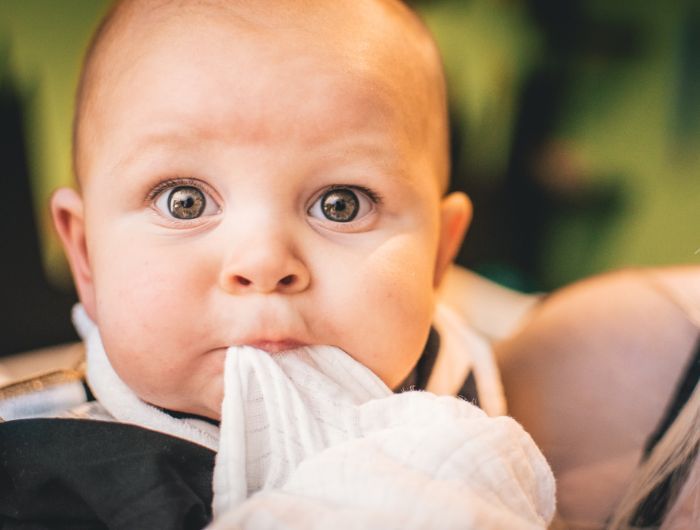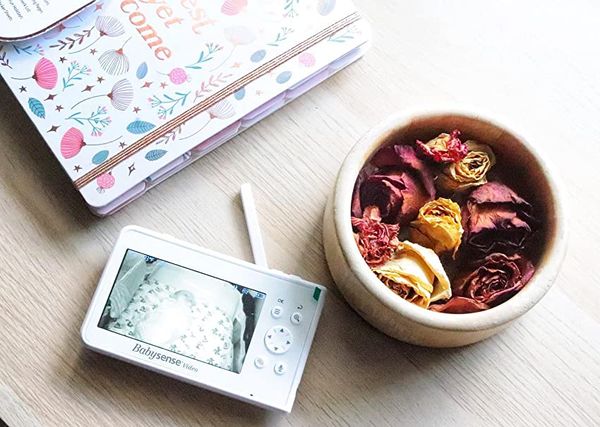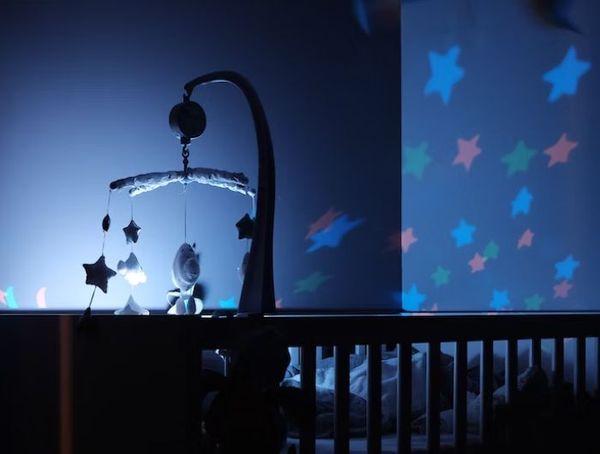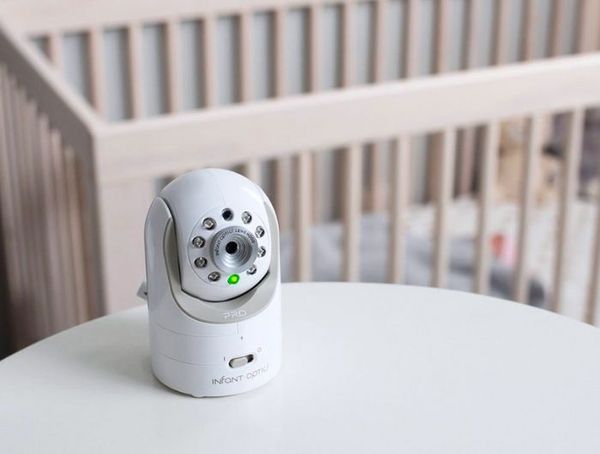Teething is a natural process that every baby goes through, but it can also cause discomfort, pain, and fussiness for your little one. This is when the best teething toys for babies can help.
What is Teething?
Teething is the term used to describe the emergence of the first set of teeth, also known as baby teeth or primary teeth, in a baby's mouth. Baby teeth start to develop before birth, and most babies have all 20 primary teeth by the time they are three years old.
Baby teeth are important for several reasons: they help your baby chew food, speak clearly, and develop a healthy smile. They also act as placeholders for the permanent teeth that will come later.
When do Babies Start Teething?
Most babies get their first tooth between 4 and 7 months of age. Some babies may start teething earlier or later than this range, and that is normal, too.
The order of the first appearance can also vary, but usually the lower front teeth (central incisors) are the first teeth to come out, followed by the upper front teeth (central incisors). Then the lateral incisors, the first molars, the canines, and the second molars follow.
How Long does Teething Last?
Teething lasts until all 20 baby teeth have erupted in your baby's mouth, which usually happens by the time your child is 3 years old. However, the intensity and duration of teething symptoms may vary from one tooth to another and from one baby to another.
Some babies may have no symptoms at all, while others may experience mild to severe discomfort for several days or weeks before and after a tooth appears.
Teething Timeline
Here follows a general teething timeline that shows what order do baby teeth come in.
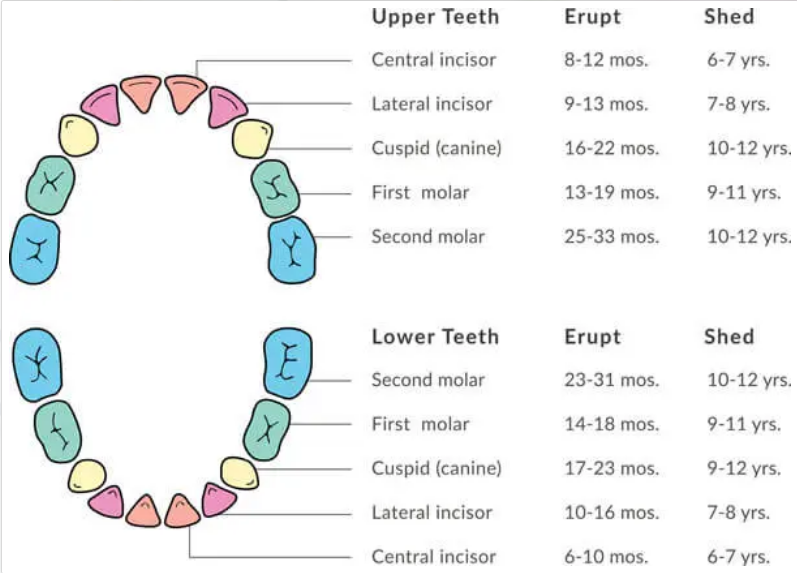
Upper Teeth
- Central incisors (the front teeth): 8 to 12 months
- Lateral incisors (the teeth on either side of the front teeth): 9 to 13 months
- Canines, or cuspids (the sharp, pointy teeth on either side of the lateral incisors): 16 to 22 months
- First molars (the back teeth used to grind food): 13 to 19 months
- Second molars (the back teeth that fill in the last gaps): 25 to 33 months
Lower Teeth
- Central incisors (the front teeth): 6 to 10 months
- Lateral incisors (the teeth on either side of the front teeth): 10 to 16 months
- Canines, or cuspids (the sharp, pointy teeth on either side of the lateral incisors): 17 to 23 months
- First molars (the back teeth used to grind food): 14 to 18 months
- Second molars (the back teeth that fill in the last gaps): 23 to 31 months
Teething Signs and Symptoms
How do you know if your baby is teething? Here are some common signs and symptoms of teething that you may notice in your baby:
Drooling
Your baby may produce more saliva than usual when teething, which can cause drooling and wetness around the mouth and chin. Drooling can also lead to skin irritation or rash on the face or neck.
Biting
Your baby may try to bite or chew on anything they can get their hands on, such as toys, fingers, pacifiers, or even your breast if you are nursing. This is because biting helps relieve the pressure and pain in their gums.
Cheek rubbing and Ear pulling
These are common signs of teething in babies. This is caused by pain in the gums, which can travel to the cheek and ear, especially when the molars are erupting. Infants will rub those areas to ease the pain.
However, ear-pulling can also be a sign of an ear infection. If you’re concerned, reach out to your child’s doctor, especially if your baby has a fever or continues to pull at their ear and seems unusually upset.
Irritability
Your baby may become more fussy, cranky, or restless when teething, especially at night when they are trying to sleep. They may also cry more often or have trouble falling asleep or staying asleep.
Swollen Gums
Your baby's gums may become swollen and red where a tooth is about to erupt. You may also see a small bump or a white spot on the gum line indicating that a tooth is breaking through.
Loss of Appetite
Your baby may lose interest in eating or drinking when teething, as their mouth may be sore or sensitive. They may also refuse to breastfeed or bottle-feed or pull away from the nipple frequently.
Fever
Some babies may develop a low-grade fever (less than 100.4°F) when teething, but this is not very common. If your baby has a high fever (more than 100.4°F) or other signs of illness such as diarrhea, vomiting, rash, or cough, it is unlikely to be related to teething and you should consult your doctor.
How To Help a Teething Baby
Teething can be a tough time for both you and your baby, but there are some things you can do to help ease your baby's teething pain and make them more comfortable.
Give them Something to Chew on
You can offer your baby a clean finger, a cold washcloth, a chilled spoon, or a teething ring to chew on to soothe their sore gums. Make sure the teething toy is not too hard or too cold and that it does not pose a choking hazard.
We have put together a list of the best teething toys for your little one.
Avoid liquid filled teething rings, which can break and leak. You can also refrigerate or freeze some breast milk or formula in an ice cube tray and put it in a mesh feeder for your baby to suck on.
Massage their Gums
You can gently rub your baby's gums with a clean finger or a soft cloth to provide some relief. You can also use a moistened gauze pad to wipe away any excess saliva or food particles from their gums and teeth.
Apply some Pressure
You can use your finger or a cold spoon to apply some gentle pressure on your baby's gums where a tooth is coming out. This can help reduce the inflammation and numb the pain.
Apply a Cold Compress
You can place a cold compress on your baby's cheek or jaw to reduce the swelling and numb the pain. You can use a frozen washcloth, a bag of frozen peas, or a cold spoon for this purpose. Do not apply ice directly to your baby's skin or gums. There are various other home remedies to help sooth your teething baby.
Distract your Baby with Fun Activities
You can try to take your baby's mind off their teething pain by playing with them, reading to them, singing to them, or taking them for a walk.
Teething Gels or Numbing Drops
You can also use teething gels or numbing drops that are safe for your baby. Always check with your pediatrician before using any medication. Dental solutions like amber teething necklaces and teething tablets are gaining popularity among parents, but there is no scientific evidence to prove their effectiveness.
It's important to keep in mind that every baby is different, and what works for one may not work for another. Try different methods until you find what works best for your teething baby.
How to Care for Your Baby’s New Teeth
It's important to take care of your child's teeth, even before their first tooth appears. Wipe your baby's gums and mouth with a clean, damp cloth after feeding to remove any bacteria.
As soon as their first teeth appear, start brushing them with a soft-bristled toothbrush and water. Avoid letting your baby fall asleep with a bottle, as this can lead to tooth decay. Instead, offer your child water or a pacifier at bedtime.
Conclusion
Teething is a natural process, and while it can be uncomfortable for your baby, it's something they will go through. Knowing when babies start teething, the signs and symptoms of teething, and how to soothe your teething baby with the best baby teething toys can help you support your little one through this milestone.
Remember to take care of your baby's teeth and schedule their first dental visit by their first birthday.
Thank you for reading Mother Bear Reviews, your favorite parenting blog!


